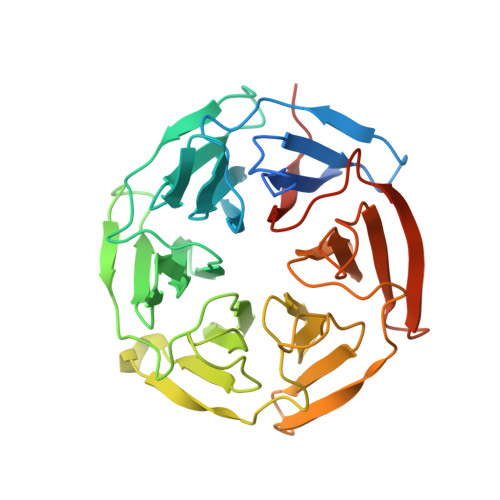Structure-Activity and Structure-Conformation Relationships of Aryl Propionic Acid Inhibitors of the Kelch-like ECH-Associated Protein 1/Nuclear Factor Erythroid 2-Related Factor 2 (KEAP1/NRF2) Protein-Protein Interaction.
Heightman, T.D., Callahan, J.F., Chiarparin, E., Coyle, J.E., Griffiths-Jones, C., Lakdawala, A.S., McMenamin, R., Mortenson, P.N., Norton, D., Peakman, T.M., Rich, S.J., Richardson, C., Rumsey, W.L., Sanchez, Y., Saxty, G., Willems, H.M.G., Wolfe 3rd, L., Woolford, A.J., Wu, Z., Yan, H., Kerns, J.K., Davies, T.G.(2019) J Med Chem 62: 4683-4702
- PubMed: 30973731
- DOI: https://doi.org/10.1021/acs.jmedchem.9b00279
- Primary Citation of Related Structures:
6QMC, 6QMD, 6QME, 6QMJ, 6QMK - PubMed Abstract:
The KEAP1-NRF2-mediated cytoprotective response plays a key role in cellular homoeostasis. Insufficient NRF2 signaling during chronic oxidative stress may be associated with the pathophysiology of several diseases with an inflammatory component, and pathway activation through direct modulation of the KEAP1-NRF2 protein-protein interaction is being increasingly explored as a potential therapeutic strategy. Nevertheless, the physicochemical nature of the KEAP1-NRF2 interface suggests that achieving high affinity for a cell-penetrant druglike inhibitor might be challenging. We recently reported the discovery of a highly potent tool compound which was used to probe the biology associated with directly disrupting the interaction of NRF2 with the KEAP1 Kelch domain. We now present a detailed account of the medicinal chemistry campaign leading to this molecule, which included exploration and optimization of protein-ligand interactions in three energetic "hot spots" identified by fragment screening. In particular, we also discuss how consideration of ligand conformational stabilization was important to its development and present evidence for preorganization of the lead compound which may contribute to its high affinity and cellular activity.
- Astex Pharmaceuticals , 436 Cambridge Science Park , Cambridge CB4 0QA , U.K.
Organizational Affiliation:

















